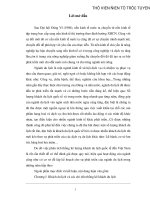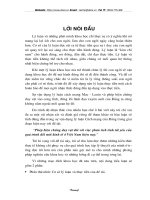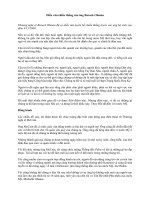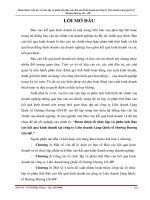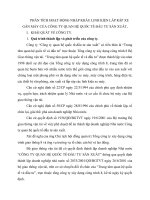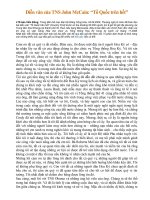Phân tích diễn ngôn phê phán bài diễn văn của michelle obama vào ngày quốc tế phụ nữ năm 2016
Bạn đang xem bản rút gọn của tài liệu. Xem và tải ngay bản đầy đủ của tài liệu tại đây (427.93 KB, 104 trang )
VIETNAM NATIONAL UNIVERSITY, HANOI
UNIVERSITY OF LANGUAGES AND INTERNATIONAL STUDIES
FACULTY OF POST-GRADUATE STUDIES
---------NGUYỄN THANH NGA
A CRITICAL DISCOURSE ANALYSIS OF MICHELLE OBAMA’S
SPEECH ON INTERNATIONAL WOMEN’S DAY 2016
(Phân tích diễn ngôn phê phán bài diễn văn của Michelle Obama
vào ngày Quốc tế Phụ nữ năm 2016)
M.A THESIS PROGRAMME I
Field
Code
: English Linguistics
: 8220201.01
Hanoi - 2019
VIETNAM NATIONAL UNIVERSITY, HANOI
UNIVERSITY OF LANGUAGES AND INTERNATIONAL STUDIES
FACULTY OF POST-GRADUATE STUDIES
---------NGUYỄN THANH NGA
A CRITICAL DISCOURSE ANALYSIS OF MICHELLE OBAMA’S
SPEECH ON INTERNATIONAL WOMEN’S DAY 2016
(Phân tích diễn ngôn phê phán bài diễn văn của Michelle Obama
vào ngày Quốc tế Phụ nữ năm 2016)
M.A THESIS PROGRAMME I
Field
: English Linguistics
Code
: 8220201.01
Supervisor : Prof. NGUYỄN HÒA
Hanoi - 2019
DECLARATION
I, the undersigned, hereby certify my authority of the study project report
entitled “A critical discourse analysis of Michelle Obama’s speech on
International Women’ s Day 2016”submitted in partial fulfillment of the
requirements for the degree of Master in English Linguistics. Except where
the reference is indicated, no other person’s work has been used without due
acknowledgement in the text of the thesis.
Ha Noi, 2019
Nguyễn Thanh Nga
1
ACKNOWLEDGEMENTS
For the fulfillment of this study, first and foremost, I would like to
express my high appreciation to my supervisor, Prof. Nguyễn Hòa, the
lecturer at Faculty of Post- Graduate, ULIS, VNU for his valuable
instructions, comments as well as his advice.
I also would like to send my thankfulness to all the lecturers of Faculty of
Post- Graduate, ULIS, VNU for their training and assistance that help me to
accomplish this M.A thesis.
Last but not least, my deep gratitude is towards to my family and my
friends for their valuable support and encouragement.
2
ABSTRACT
This study aims at investigating and figuring out the ideologies
embedded in the speech delivered by First Lady of the 44 th U.S. president,
Barack Obama from 2009 to 2017 on International Women’s Day 2016 in
Washington D.C.’s Union Market in front of dozens of adolescent girls in the
Let Girls Learn from Critical Discourse Analysis (for short CDA) perspective.
In this study, the main dialectical – relational framework provided by Norman
Fairclough is used to achieve its objective. According to Fairclough’s CDA
framework, the study conducts three major steps. The analysis interprets data
in three different levels: text analysis (description), processing analysis
(interpretation) and social analysis (explanation). Each above phase can be
sub- divided into three categories (experiential, relational, expressive). The
conclusion supports her ideology that it is necessary that there be an equality
for women in education across the globe, and she therefore calls for the
approval and support from all corners of the world. It also confirms the
relationship between language and ideology in CDA and suggests some
implications in language research and pedagogy.
3
LIST OF ABBREVIATIONS
1. CDA:
2. SFG:
3. MR:
Critical Discourse Analysis
Systemic Functional Grammar
Members’ Resource
TABLE OF CONTEN
4
DECLARATION..............................................................................................i
ACKNOWLEDGEMENTS............................................................................ii
ABSTRACT....................................................................................................iii
LIST OF ABBREVIATIONS........................................................................iv
TABLE OF CONTENT..................................................................................v
LIST OF FIGURES AND TABLES.............................................................vii
CHAPTER 1: INTRODUCTION..................................................................1
1. Rationale....................................................................................................1
2. Scope of the study.....................................................................................2
3. Aims of the study and research questions..............................................2
4. Methodology of the study.........................................................................2
5. Design of the thesis...................................................................................2
CHAPTER 2THEORETICAL BACKGROUND& LITERATURE
REVIEW..........................................................................................................5
2.1. Definitions of CDA................................................................................5
2.2. Principles of CDA..................................................................................6
2.3. Some key concepts in CDA...................................................................6
2.4. Approaches to CDA...............................................................................8
2.5. Review of previous studies..................................................................16
CHAPTER 3: RESEARCH METHODOLOGY........................................19
3.1. Reasons to choose the speech..............................................................19
3.2. Context of the speech...........................................................................20
3.3. Data analysis procedure......................................................................21
3.4. Fairclough ’s CDA framework...........................................................21
CHAPTER 4: FINDINGS AND DISCUSSION..........................................26
5
4.1. Textual description and Analysis........................................................26
4.1.1. Appreciating women’s achievements.............................................26
4.1.2. Sympathizing with women’s inequality.........................................28
4.1.3. Supporting with women’s equality in education..........................32
4.2. Interpretation of the relationship between the productive and
interpretative processes..............................................................................41
4.2.1. Interpretation of situational context..............................................41
4.2.2. Intertextual context and presupposition........................................42
4.3. Explanation of the relationship between discourse processes and
social processes............................................................................................43
CHAPTER 5: CONCLUSION.....................................................................47
1. Recapitulation.........................................................................................47
2. Conclusion...............................................................................................48
3. Implications.............................................................................................49
4. Limitations..............................................................................................51
5. Recommendations...................................................................................52
REFERENCES..............................................................................................53
APPENDICES..................................................................................................I
APPENDIX 1....................................................................................................I
APPENDIX 2..................................................................................................X
APPENDIX 3.............................................................................................XXX
APPENDIX 4.....................................................................................XXXVIII
APPENDIX 5................................................................................................XL
6
LIST OF FIGURES AND TABLE
Figure 2.1. Discourse as text, interaction and context (Fairclough, 2001,
p.21)................................................................................................................10
Table 2.1. Overview of process types (adapted from Halliday, 1994).......13
Table 2.2. Basic speech role (Thompson, 1996, p. 40)................................14
Table 2.3. Components of a multiple theme (adapted from Halliday, 1994,
p.54)................................................................................................................15
Figure 3.1.
Interpretation (Fairclough, 2001, p. 119)..............................23
Figure 3.2. Explanation (Fairclough, 2001, p. 36)......................................25
Y
7
CHAPTER 1: INTRODUCTION
This part includes rationale, scope, aims, methodology and design of
the thesis.
1. Rationale
It is clear that language is the most important characteristic of human
society, and it plays an important role in demonstrating human social
relationship. Therefore, researching the relationship between language and
human society has attracted many researchers’ attention, especially linguists’.
Those who take interest in this relationship apply the knowledge in Critical
Discourse Analysis (CDA for short) to describe, interpret and explain these
relationships. According to Fairclough and Wodak (1997), that CDA
addresses social issues is one of foundational principles of this critical
approach. Not only does it describe language but it also provides critical
linguistic resources to linguists who want to discover social relations
underlying in a wide number types of discourse in terms of both their
linguistic factors and contexts. This can help to uncover the relationship
between language and human beings’ issues such as right, ideology or power.
Similarly, with the hope of conducting the study, I want to analyze Michelle
Obama’s speech on International Women’s Day 2016 from CDA perspective.
This address is considered as a doctrine presented by Michelle Obama as First
Lady of the US on behalf of all women around the world. Through her
speech, Michelle Obama hopes to emphasize the reasons why fighting for
women’s rights and finding out the equality for all women, especially in
education in the modern societyare absolutely indispensable. More
importantly, the study’s underlying aims is to illustrate CDA concepts and
discover how language is encoded in the speech delivered by Michelle Obama
1
on International Women’s Day 2016 in D.C. The speech provokes a
significant effect on public opinion; hence, it may lead to the change in
women’s awareness about their own rights. In the procedure of conducting the
study, I want to demonstrate how social issues are underlying in language. It
is also expected to provide some suggestions about critical reading of any
texts to researchers and some implications for teaching and learning a foreign
language as well.
2. Scope of the study
This study explores the First Lady Michelle Obama’s speech on
International Women’s Day 2016 in Washington D.C.’s Union Market in front
of dozens of adolescent girls in the “Let Girls Learn” from CDA perspective.
3. Aims of the study and research questions
The study is carried out for the purpose of exploring ideologies of the
First Lady Michelle Obama’s speech on International Women’s Day 2016
based on Fairclough’s CDA framework.
In order to achieve the above mentioned aims, the following research
questions need to be found:
- What are the messages that the speaker created in her speech?
- How are these messages highlighted and constructed linguistically?
4. Methodology of the study
This study uses CDA framework, particularly Fairclough’s threedimensional framework. The analysis interprets data in three different levels:
text analysis (description), processing analysis (interpretation) and social
analysis (explanation). Each above phase can be sub- divided into three
2
categories (experiential, relational, and expressive).
5. Design of the thesis
Apart from references and appendices, the study is divided into five
main chapters as below:
Chapter 1: Introduction
This part includes rationale, scope, aims, methodology and design of
the thesis.
Chapter 2: Theoretical framework and literature review
This chapter presents an overview of the history of CDA and mentions
some definitions of CDA that give knowledge in understanding of CDA as a
discipline. Some key concepts in CDA, including identity, power and
ideology and some approaches to CDA are also presented in this part.
Furthermore, it summarizes some previous researches from CDA perspective
to provide the thorough knowledge in CDA.
Chapter 3: Research methodology
This chapter mentions the reasons to choose the topic and the context
of the given address. Additionally, it provides information about the
organization “Let Girls Learn”. Also, the dialectical– relationalapproach by
Norman Fairclough and the data analysis procedure of Michelle Obama’s
speech on International Women’s Day 2016 are presented.
Chapter 4: Findings and discussion
This chapter explores critical discourse analysis of Michelle Obama’s
speech on International Women’s Day 2016, mainly based on Fairclough’s
CDA three-dimensional framework.It is an illustration and demonstration for
what ideologies Michelle conveys and how they are expressed linguistically
3
in her speech. Also, it interprets the relationship between the productive and
interpretative process and explains that between discourse processes andsocial
ones.
Chapter 5: Conclusion.
This is the very last part of the thesis that gives a brief summary of the
main findings of the study, draws some significant conclusions and makes
some further research suggestions as well.
4
CHAPTER 2
THEORETICAL BACKGROUND& LITERATURE REVIEW
This chapter presents an overview of the history of CDA and mentions
some definitions of CDA that give knowledge in understanding of CDA as a
discipline. Some key concepts in CDA, including identity, power and
ideology and some approaches to CDA are also presented in this part.
Furthermore, it summarizes some previous researches from CDA perspective
to provide the thorough knowledge in CDA.
2.1. Definitions of CDA
Critical discourse analysis, abbreviated CDA, is a fairly new branch of
linguistics. CDA is “a type of discourse analysis research that primarily
studies the way social power abuse, dominance, and inequality are enacted,
reproduced, and resisted by text and talk in social and political contexts” (Van
Dijk, 2004, p. 352).
From another perspective, Fairclough (1995) proposes a definition of
CDA, accepted and commonly used among CDA practitioners. He defines
CDA as discourse analysis that aims to systematically explore causal
relationships and fuzzy decisions between practice, facts and text, and
structures, relationships and too wider cultural and social agenda; to
investigate how these practices, events and texts arise and are ideologically
shaped by power relations and power struggles; and to explore how the
opacity of discourse and social relations is itself a factor to ensure power and
hegemony. He also puts CDA as “viewing language use as social practice
implies, first, that it is a mode of action, in a dialectal relationship with other
facets of the social (its social context) – it is socially shaped, but is also
socially shaping, or constitutive” (Fairclough, 1995, p.131).
5
Personally, in this thesis, I totally agree with Van Dijk’s definition.
2.2. Principles of CDA
Principles of CDA, outlined by CDA practitioners (Fairclough, 1995;
Kress, 1991; Van Dijk, 1998; Wokak, 1996) can be summarized as follows:
- Language is social practice through which the world is represented
- Discourse/ language use as a form of social practice in itself not only
presents and signifies other social practices but it also constitutes other
social practices such as the exercise of power, domination, prejudice,
resistance and so forth.
- Text requires their meanings by the dialectical relationship between
texts and the social subjects: writers and readers, who always operate
with various degree of choice and access to texts and means of
interpretation.
- Linguistics features and structures are not arbitrary. They are
purposeful whether or not the choices are conscious or unconscious.
- Power relations are produced, exercised, and reproduced through
discourse.
- All speakers and writers operate from specific discursive practices
originating in special interests and aims which involve inclusions and
exclusions.
- Discourse is historical in the sense that texts require their meanings by
being situated in specific social, cultural and ideological contexts, and
6
time and space.
- CDA does not solely interpret texts, but also explains them.
2.3. Some key concepts in CDA
Language and power
As Van Dijk (1993), power is related to control, particularly by a group
compared to other groups. Such control may be related to action and
awareness: that is, a strong group can limit the freedom of action of others,
but also affects their minds. And he comes to the conclusion that, managing
the minds of others, it is basically a function of writing and talking.According
to the relationship between power and language, it can be affirmed
that“language actually creates power, as well as being a site where power is
performed”. (Wareing, 2004, p.10)
Fairclough agrees at the point where there is a close relationship
between language and power. Fairclough argues that strength can be seen in
discourse where participants are disproportioned.
Language and power exist in a close relationship, in which language
indexes strength, demonstrates power and also challenges power. Power does
not come from language but can be challenged by language. A textual power
is signaled not only by grammatical forms but also by the type of text a
person uses to control a social goal.
Language and ideology
Ideology plays an important role in CDA. Ideology is the set of belief’s
underlying an utterance or discourse. Irvine (1989) redefines ideology as “the
cultural system of ideas about social and linguistics relationships, together
with their loading of moral and political interests” (p.255). According to Van
Dijk, “ideologies” are considered as “interpretation frameworks” that
“organize set of attitudes” towards other elements or modern society.
Consequently, ideologies provide the “cognitive foundation” for the attitudes
7
of different groups in society, as well as promote their own goals and
interests.
Fairclough (1995) argues that there is an important relationship
between the features of text and ideology, which lies in the ideological
investment of the factors created in the production or interpretation of a text
version, and in such a way that these elements are articulated together and the
discourse orders are rearranged in discourse events.
It can be seen the relationship between language and power and
language and ideology. The similarity, a close relationship is found to exist
between power and ideology. Power and ideology are tied together in the
sense that ideology helps to secure power, and vice versa, power makes
ideology predominate.
2.4. Approaches to CDA
Socio-cognitive approach (Van Dijk)
Van Dijk is a pioneer who developed a method of social cognition in
which an important aspect is incorporated into the human mind. His
contribution to CDA has been in developing a sociocognitive model, with a
focus on the discursive reproduction of racism, in particular, by politicians,
journalists, scholars and writers, and in printed news media. His
sociocognitive approach attempts to bridge the gap between society and
discourse. Working from a metal models approach, he sees discourse,
processed via long- and short-term memory, as shaping our perceptions and
understandings. By analyzing the structure, he gives an analysis of the
structures on different levels of description, which means not only at the
grammar, phonological, morphological and semantic levels but also “higher
level properties”, such as coherence, overall theme and the theme of new
stories. It is that inductively oriented approaches do not sufficiently imbue the
8
analysis with a comprehensive and holistic understanding of the dialectical
relationship between discourse and social practice. What it does mean is that
they are better incorporated into other deductively oriented approaches, as is
the case in the current study and its focus on the socio-cognitive level. As
aforementioned, this approach can offer more insights into the wider context
beyond the textual level.
Discourse-historical approach (Ruth Wodak)
The discourse-historical approach emphasizes the cornerstones of
CDA, such as critique, power and ideology, and their intricate and
multidimensional relationship with discourse (Reisigi & Wodak, 2009). As
indicated by its name, it understands context as being “mainly historical”
(Wodak & Meyer, 2009, p. 26), thus it is necessary to examine the historical
context in order to offer interpretations and further critiques. Being mainly
focused on the field of politics, it makes a strong emphasis on the historical
context and takes it as part of interpreting a discourse. During the analysis
process, both theory and actual documentation are required. Additionally,
recontextualization plays an important role in exploring the relationship
between genres and the topic of a discourse. In general, Wodak’s approach is
much more ethnographic than Fairclough’s. She is also interested in the role
of history in discourse (Martin & Wodak, 2003), labeling her approach the
approach the discourse historical method (Wodak, 2001b).
Dialectical- relational approach (Norman Fairclough)
Norman Fairclough is considered as the most impressive and influential
practitioner in CDA as he has contributed to the field most significantly. His
main objective in his approach is “to help increase consciousness of how
language contributes to the domination of some people by others, because
consciousness is the first step for emancipation” (1989, p.1).
Fairclough systematizes discourse in terms of social structure, which is
9
represented in more abstract element of languages. Fairclough develops a
dialectical theory of discourse and a trans-disciplinary approach to social
change. Social practices are represented in orders of discourse, and social
events are realized in texts. His works focus upon social conflicts and try to
detect their linguistic manifestations in discourses, in particular elements of
dominance, difference and resistance. Discourse analysis, in this view, has a
doubly relational character: it is concerned with relations between discourse
and other social elements (i.e., text analysis), and relations between texts as
discoursal elements of events and “orders of discourse” as discoursal
elements of networks of social practices. In his approach, every social
practice has a semiotic element. Productive activity, the means of production,
social relations, social identities, cultural values, consciousness and semiosis
are dialectically related elements of social practice. Semiosis incorporates
discourse analysis into social and organizational research that includes the
claim that such research should include detailed analysis of texts. He
understands CDA as the analysis of the dialectical relationships between
semiosis (including language) and other elements of social practices.
Therefore, once CDA sees language as discourse and as social practice,
not just analysis of texts, productive and interpretative processes is needed,
the relationship between texts, processes and their conditions are to be
considered. Figure 1 below provides an illustration of this relationship.
Social conditions of production
Process of production
Text
Process of interpretation
Interpretation
Context
Figure 2.1. Discourse as text, interaction and context (Fairclough, 2001, p.21)
10
A three-dimensional method of discourse analysis includes “linguistic
description of the language text, interpretation of the relationship between the
(productive and interpretative) discursive processes and the text, and
explanation of the relationship between the discursive processes and social
processes” (Fairclough, 2013, p.132). In recognition of the dialectical
relationship between text, discourse practice and sociocultural practice, it is
understood that “the nature of the discourse practice of text production
shapes the text, and leaves traces in surface feartures of the text; and the
nature of the discourse practice of text interpretation determines how the
surface features of a text will be interpreted” (Fairclough, 2013, p.132).
Fairclough’s approach draws upon a particular linguistic theory
-Systemic Functional Grammar (SFG) by Halliday (1985) – which analyses
language as shaped (even in its grammar) by the social functions it has come
to serve. The focus of this method is on the semiotic characteristics of
discourse.In his book Language and Power (2001), Norman Fairclough
supplies a more meticulous and clear method. In his opinion, the systemicfunctional theory of language is especially useful in text analysis because not
only is its approach to studying grammar and other aspects of language form
a functional one but
it is also systematically orientated to studying the
relationship between the texture of texts and their social contexts. Besides, it
contains “through a systemic relationship between the social environment on
the one hand, and the functional organization of language on the other”
(Halliday, 1985, p.11).
Language includes both the potential to mean and the act of meaning
which brings that potential to life. Halliday explains that it can be considered
a problem-oriented theory, in the sense that it is designed to assist in
identifying and tackling problems that arise from outside itself, that is, not
problems that the theory identifies for itself. This means that the questions it
11
sets out to answer are usually questions which are faced by people who are
not linguists but are engaged in some activity or issue in which language
plays a role. It is an applicable theory and its development has been driven by
the ongoing experience of its use and by its constant extension into new areas
of research. (Halliday, 2009).
Norman Fairclough (1991) suggested in the study of Discourse &
Society that “Systemic-functional linguistics also has a view of texts which is
a potentially powerful basis not only for analysis of what is in texts, but also
for analysis of what is absent or omitted from texts”. As a result, Halliday’s
functional grammar is also our focus.
The Systemic Functional Grammar is the main foundation of Critical
Discourse Analysis and other theories in pragmatics as well. The SFG says
that we perform functions through language, i.e. what we intend to do with a
piece of language. Clearly, speakers have reasons for saying something and
for saying it in the way they do. Therefore, speakers have to make choices.
SFG sets out to discover what various relevant choices are, not only in the
kinds of meanings that we might want to express (or functions that we might
want to perform) but also in the kinds of wording that we use to express these
meanings.
According to Thompson (1996), within SFG, three kinds of meaning
(or functions) have been identified:
- We use language to talk about our experience of the world, including
the worlds in our own minds, to describe events and states and the entities
involved in them (experiential meaning).
- We also use language to interact with other people, to establish and
maintain relations with them, to influence their behaviors, to express our own
viewpoint on things in the world, and to elicit or change theirs (interpersonal
meaning).
- Finally, we organize our message in ways which indicate how they fit
12
in with the other messages around them and with the wider context in which
we are talking or writing (textual meaning).
The three above metafunctions of language are realized at the LexicoGrammar at the unit called clause. A clause is defined as “(potentially) any
stretch of language centred on a verbal group” (Thompson, 2004, p. 17).
Experiential meaning is expressed through the System of Process
Types (or Transitivity system). The system of transitivity consists of different
process types, participants and circumstances. Processes are expressed by
verbal groups, participants by nominal groups, and circumstances by
adverbial groups or prepositional phrases. The process centers on that part of
the clause that is realized by the verbal group, but it can also be regarded as
what “goings-on” are represented in the whole clause (Bloor and Bloor,
1995). In English, SFG linguists divide process types into six types: material
process, behavior process, mental process, verbal process, relational process,
and existential process.
Table 2.1. Overview of process types (adapted from Halliday, 1994)
Process types
Category
meanings
Participants
Material
Action
Actor,
Recipient
“doing”
Event
“happening”
Behavioural
“behaving”
Behaver,
(Phenomenon)
Mental
Perception
Affection
Cognition
“feeling”
“sensing”
“emotive”
“thinking”
Senser,
Phenomenon
13
Example
Goal,
The mayor dissolved
the committee.
The mayor resigned.
She cried softly.
I heard a noise
outside.
The boy loved the girl.
You can imagine his
reaction.
Verbal
“saying”
Relational
Attribution
Identification
“being”
“attributing”
“identifying”
Existential
“existing”
Sayer,
Target, I explained to her what
Verbiage,
it meant.
Recipient
Carrier, Attribute This bread is stale.
Identified,
Pat is her brother.
Identifier/ Value,
Token
Existent
Maybe there’s some
other darker pattern.
Interpersonal meaning makes attempts to answer the question “How
do we use language to exchange?”. This type of meaning is encoded under
the headings of the roles of addressers and audience, mood, modality and
evaluation. According to Thompson (1996),interpersonal meaning is analyzed
in terms of personal perspective (modality and evaluation) and interactive one
(enacted roles and projected roles).
The most fundamental purposes in any exchange are giving or
demanding a commodity of some kind. In a communicative exchange, the
commodity is information. In these cases, speech roles are realized.
Thompson (1996) provides a table to characterize the primary speech roles as
follows with some adaptations from that of Halliday’s (1994).
Table 2.2.Basic speech role (Thompson, 1996, p. 40)
Role
exchange
in Commodity
change
(a)
goodservices
&- (b) information
(i) giving
Offer
Statement
I’ll show you the We’re nearly there.
way.
(ii) demanding
Command
14
Question
Give me your hand.
Is this the place?
One concept that may be useful of understanding of modality is
polarity. Polarity is the choice between positive and negative, as in is/ isn’t,
do/ don’t, ect. However, the possibilities are not limited to a choice between
yes and no. There are intermediate degrees that are collectively known as
modality.
In discussing interpersonal meaning, it is important to note that
evaluation is central part of the meaning of any text, any analysis of the
interpersonal meaning of a text must take it into account. According to
Thompson (1996), “Evaluation can be simply defined as the indication of
whether the speaker thinks that something (a person, thing, action, event,
situation, idea, ect.) is good or bad.”
Textual meaning finds outa respond to the question “How the content
of the text organized?”. In terms of textual meaning, thematic structure is
under investigation. The textual meaning deals with creating relevance
between parts of what is being said and between the text and the context.
Lexico-grammatically, it is expressed through the system of theme and
information focus. Relevant to the realization of the system of theme are two
elements: the Theme and the Rheme. The Theme serves as the point of
departure of the message, which in English is initial elements of the clause;
and the Rheme is the remainder of the message. Theme may be unmarked or
marked. Theme may be either marked or unmarked. An unmarked theme is
one that usual whereas a marked one is one that unusual to express the
communicative purpose. Also, the theme is multiple when owning further
internal structure.
Table 2.3. Components of a multiple theme(adapted from Halliday, 1994, p.54)
15
Metafunction
Components of Theme
Example
Experiential theme
Topical
elements Elements
playing
as
(participant,
Actor/
Agent,
Goal/
circumstances, process)
Medium, Circumstance in
the clause
Textual theme
Continuative elements
Yes, no, well…
It now can be seen that both CDA and SFG approach functionally to
textual analysis through studying grammar and other aspects of language
form, and they are systematically orientated to studying the relationship
between the texture of texts and their social contexts.
Thus, from the above one can see that SFG theory firstly, fits well with
Fairclough’s understanding of language and discourse as having a meaningmaking potential and secondly, that SFG is applicable for this study to help
identify as well as tackling the problem of the debate on development aid.
2.5. Review of previous studies
In order to develop and complete this thesis about Critical Discourse
Analysis concerning female issues, here are several related previous
researches.
The first research is written by Frida Ekerlund (2013), “Gender
Equality” and “The Empowerment of Women” – A Critical Discourse
Analysis on UN Women’s Policy Mandate. It reveals how women need to
change in order to accomplish “equality”, how the policies are sometimes
contradictory, but advocating women’s integration into formal economy,
which in itself is rendered apolitical.
The second previous one “A Critical Discourse Analysis on Hillary
Clinton’s speech American for Marriage Equality” by Rifki Nugraha (2014) is
16
